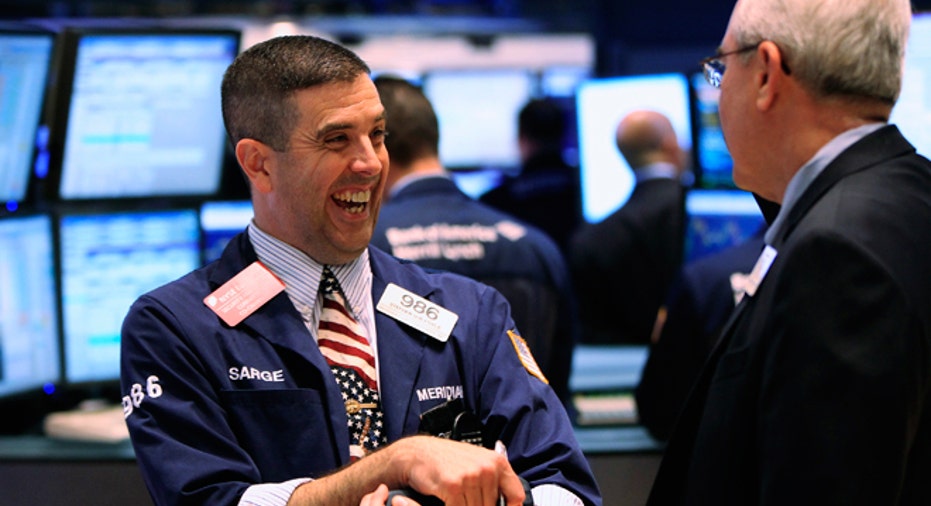A Green January Could Set Bullish Tone for 2013

Wall Street’s euphoric kickoff to the new year was largely a knee-jerk reaction to Washington staving off a steep tumble over the fiscal cliff. But if the markets can hold onto their early gains in spite of looming political battles ahead, it would bode very well for 2013.
Since 1970, the Dow Jones Industrial Average has generated a positive return for the calendar year 93% of the time it notched a gain in January, according to Dow Jones Market Data. Other data reveal annual returns are also stronger in years when stocks end January in the black.
“When the new year starts, optimism kicks in and acts as a buying pressure,” said Chris Beauchamp, a market analyst at IG Markets. “The market looks to January to set the tone for the rest of the year.”
Bullish Omen?
That optimism was in full force this week as the blue chips surged 308 points, or 2.35%, on Wednesday largely in response to a last-minute budget fix in Washington.
The emphatic start to trading marked the Dow’s largest point gain to start a new year on record and also the index’s fifth year in a row of debuting with strong gains.
“Global markets soared universally and pundits everywhere gave credit to the limited fiscal cliff ‘compromise’. That was true to some degree but it wasn't the whole story. You needed to look at the calendar also,” Art Cashin, UBS’s (NYSE:UBS) director of floor operations at the New York Stock Exchange, wrote in a note.
Last year the benchmark index soared 415.35 points, or 3.4%, in January -- its strongest January performance since 1997. Those gains helped to contribute to the blue chips’ 7.26% rally in 2012.
History shows that Wednesday’s rally could be a bullish omen for 2013. January’s performance has predicted the outcome of the full year in 86 of the Dow’s 115 years, or 75% of the time, according to Dow Jones.
It should be no surprise, then, that the blue chips have suffered a yearly loss 62% of the time when stocks posted a January decline.
‘January Effect’ Eyed
A green start to the year also tends to lead to stronger gains for the whole year.
According to IG Markets, the Dow has generated an average annual return of 13.99% since 1984 after a positive January, compared with 9.34% in all of those years.
All of these stats point to the influence of the “January Effect.” This market axiom holds that stocks tend to rise early in the year as investors who sold stocks at the end of the year to book profits or register losses for tax purposes pile back in when the calendar flips.
“If you have a difficult year, you put that behind you. You almost have a New Year’s resolution to see how you can do it differently this year,” said Beauchamp.
Of course, like most of these historical trends, there are exceptions to the rule.
For example, the Dow suffered an 8.84% plunge in January 2009 as the U.S. struggled to escape the worst financial crisis since the Great Depression. Investors following the January rule then would have missed out on that year’s 18.82% surge as optimism returned and the recession ended.
On the other hand, U.S. stocks enjoyed a positive January in 2001, only to close that year in the red in the aftermath of the September 11 terrorist attacks.
2013 Outlook
It’s way too early to tell whether the enthusiastic start to 2013 will carry through to the rest of the month and the year.
While equity investors were relieved at the fiscal-cliff fix, they must also grapple with the fact that the compromise leaves unsettled the matter of raising the $16.4 trillion U.S. debt ceiling and halting $90 billion in mandated spending cuts.
Still, investors’ global headaches appear to have eased, for now.
Geopolitical jitters about violence in the Middle East have taken a backburner, as have worries about China’s slowdown. And Europe’s sovereign debt crisis has cooled down considerably in recent months.
This week BMO Capital Markets (NYSE:BMO) set a 1575 price target for the S&P 500 in 2013, which translates to a healthy return of 10.4% from the index’s 2012 close at 1426.19.
Despite “less than stellar” earnings growth, Brian Belski, chief investment strategist at BMO, told clients he sees “favorable trends in valuation, market and business cycle, asset allocation and mutual fund performance.”
The near-term focus is decidedly on the U.S.’s fiscal headwinds, but some see reason for cautious optimism there too.
“It seems policymakers always pull something out of a hat,” said Beauchamp.



















